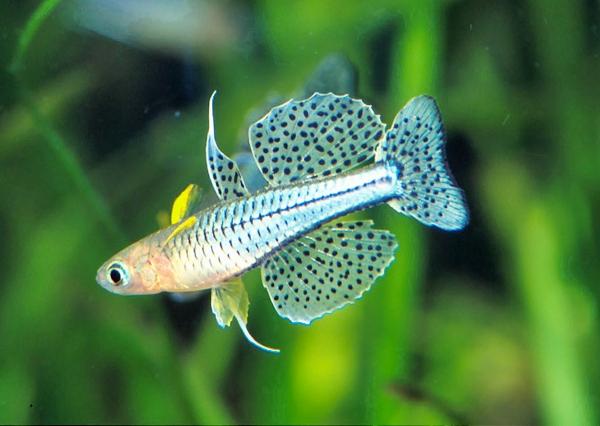
This is a large file and may take time to load [File Last updated 20/09/2007]
|
|
|
 |
Forktail Blue Eyes - Pseudomugil furcatus (Nichols1955) Forktail Rainbowfish.
Male P. furcatus displaying erect fins. |
Description: Slender fishes with blue eyes, erectile fins, forked tail. Diagnosis: Dorsal spines (total): 4-7; Dorsal softrays (total): 7-9; Anal spines: 1-1; Anal soft-rays: 15-18. Distribution: known only from
parts of
the lowlands of eastern Papua New Guinea. Water Requirements: Flowing, neutral to slightly basic, clean freshwater; pH=7.6, H=14, water temperature 25°C. Good filtration required. |
Tank Habitat: Well planted tank with open
swimming spaces.
Diet: omnivorous; takes small crustacea
and insect larvae; will eat flake foods, blood worms and daphnia.
Sexing: Males have brighter fin
colouring.
Reproduction: egg layer
Tank Community: Peaceful, active in
shoals;
keep with small fish or in a species tank.
Comments: Keep these fish in shoals
of 6+ with plant cover.
Pacific Blue-Eye - Pseudomugil signifer (Kner 1866)
Male Pacific Blue-eyes in display attitude.
|
Pseudomugil signifer (Kner 1866) Pacific Blue-Eye; Australian Blue-Eye, Southern Blue-Eye.
Description: Thin, active fish, with large, iridescent blue eyes, olive-green body with a row of iridescent green and black bars along the lateral line and with an iridescent patch at the markedly narrow beginning of the caudal fin; males have distinctive high-pointed, erectile fins, yellow edged in black. Distribution: endemic to Northern and North Eastern Australia.
Natural Habitat: Occurs in clear, cool,
fast-flowing
streams and also brackish mangrove estuaries; benthopelagic,
freshwater,
brackish; pH range: 6.5 - 7.5; dGH range: 12.0 - 15.0. Climate:
tropical;
23 - 28°C.
|
Reproduction: dioecism; fertilization
is external; egg scatterers in open water or on substrate;
non-guarders.
Tank Community: Males show territorial
aggression and display flared fins, but do not nip other fishes.
Comments: Can be kept with small Tanganyikan cichlids such as
Lemon
Cichlids and Julies.
Pseudomugil
connieae (Allen 1981)
Description: An
attractive, small fish with iridescent blue lateral stripe;
Distribution: occurs within a 50 km radius
of Popondetta, eastern Papua New Guinea. Generally found in clear,
moderate
to fairly rapid flowing streams in both shaded rainforest or sunlit,
exposed
sections. The altitudinal range is from about 30-300 m.
Natural Habitat: pelagic (lives at or near
the surface); freshwater;
pH range: 7.7 - 7.9; dGH range: 10.0.
Conservation Status: Not in IUCN Red List.
Threats: Habitat
destruction, pollution, over catching for aquarium trade.
Size: Max. size: 5.0 cm SL; 4.0 cm SL
(female)
Water Requirements: aquarium conditions:
pH=7.7, H=14, 28°C water temperature
Tank Habitat: tropical, riverine, with
some water movement, open swimming spaces and plant cover.
Diet: An omnivore
Sexing: finnage
of males is a give-away!
Reproduction: egg laying: no details
available.
Tank Community: peaceful community fish.
Incompatible Species: larger fish.
Comments: "Connies" need room to swim.
Water Requirements: adaptable to
freshwater
or brackish water, as above.
Tank Habitat: open swimming spaces with
vegetation or log and branch retreats.
Diet: Omnivorous.
Sexing: Males have elongated fins.
Reproduction: egg layer.
Tank Community: peaceful.
Easy to keep.
Incompatible Species:
large Archer Fish, Arowana, fin nippers.
Comments:
Needs weed cover and shelter provided by plants or branches.
Diet: An omnivore.
Sexing: finnage
of males is a give-away!
Reproduction: egg laying: usually attached
to plants in open water.
Tank Community: a peaceful community fish;
compatible with other Rainbowfish.
Incompatible Species: Fin
nippers; Archer Fish.
Comments: Not an
easy fish to keep; susceptible to water acidification or sudden pH
drop;
maintaining good water quality, with frequent water changes is
essential.
![]()
![]()
THANKYOU FOR VISITING ANOTHER
WATERSHED AQUACULTURE EDUCATIONAL SITE